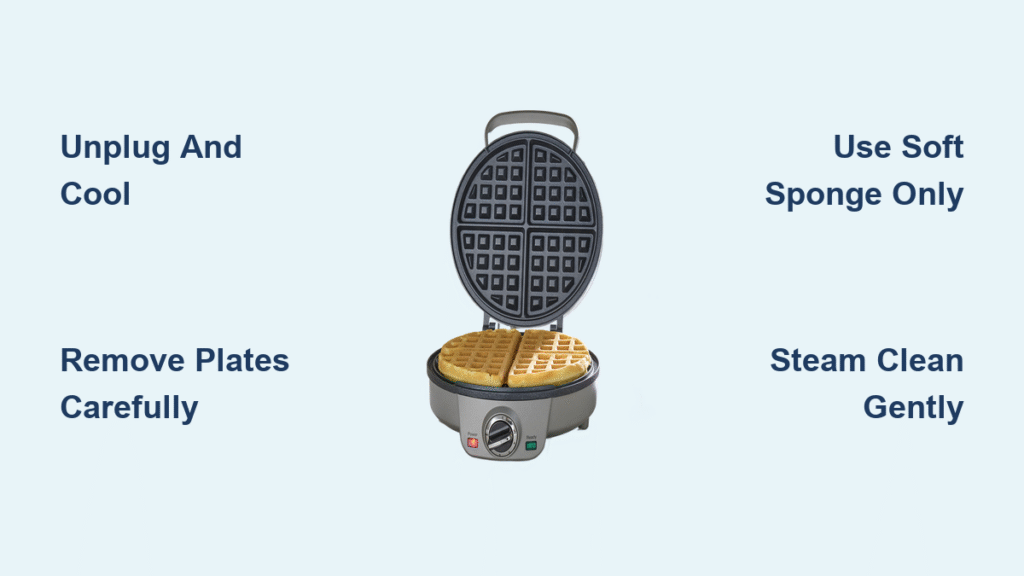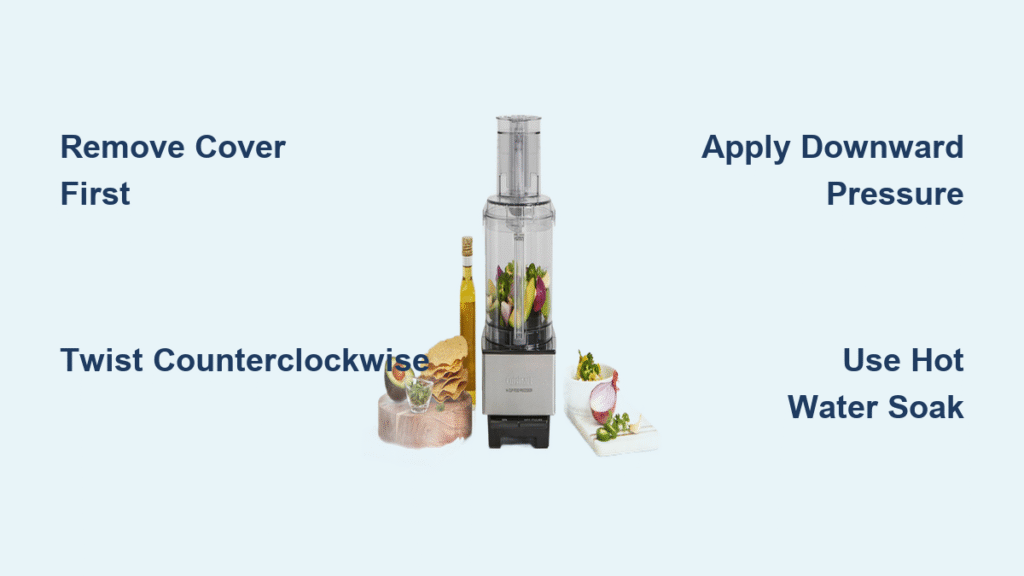That stubborn black ring circling your Cuisinart pan after searing salmon? The rainbow-hued heat tint from overheating? You’re not stuck with damaged cookware forever. Burnt-on food and polymerized oil stains plague even seasoned home cooks, but stainless steel’s resilience means you can restore professional-grade shine using pantry staples and targeted techniques. This guide delivers battle-tested methods specifically for Cuisinart stainless steel pans—no harsh scrubbing or toxic chemicals required.
Most users make the critical error of attacking burnt residue immediately after cooking. Wait! Thermal shock from cold water hitting hot metal warps the pan’s base, ruining its heat distribution. Instead, let your Cuisinart pan cool completely while you gather supplies. You’ll discover why vinegar boils away mineral deposits, how baking soda paste dissolves decade-old grime overnight, and which commercial cleaner actually works faster than DIY solutions for rainbow discoloration. By the end, you’ll know exactly which method to use for fresh spills versus vintage pan restoration.
Essential Safety Steps Before Cleaning
Never submerge a hot pan in cool water—this extreme temperature shift causes irreversible warping in Cuisinart’s multi-ply construction. Allow pans to cool on the stovetop for 20 minutes minimum. Even warm pans risk steam burns during boiling methods, so keep oven mitts within reach. When handling solutions above 140°F (like vinegar boils), wear rubber gloves to prevent chemical burns from acidic cleaners. Always work near a sink with running water to immediately rinse accidental splashes from skin. Crucially, never mix Bar Keepers Friend with vinegar—this creates chlorine gas that damages lungs and corrodes metal surfaces.
Required Cleaning Tools for Cuisinart Pans

Must-Have Items for Daily Maintenance
- Green Scotch-Brite pad (not blue): Specifically designed for stainless steel without scratching
- Long-handled OXO dish brush: Reaches corners where burnt bits hide near riveted handles
- Dawn Power Wash dish soap: Cuts through polymerized oil faster than natural alternatives
- Wooden spoon: Safely scrapes charred food during boiling without marring surfaces
- Toothpicks: Unclogs gunk trapped in handle rivet crevices
Specialized Tools for Extreme Burnt-On Residue
- Bar Keepers Friend powder: Oxalic acid formula dissolves rust-colored heat tint
- Coarse kosher salt: Creates instant abrasive paste with lemon juice for side stains
- 12-quart stock pot: Large enough to submerge 12-inch Cuisinart pans for deep restoration
- Silicone-tipped tongs: Safely lift boiling pans without scratching
Quick Fix for Fresh Burnt Food Spills
Basic Degrease and Scrub (Under 5 Minutes)
When you catch burnt residue within an hour of cooking, skip intensive methods. First, scrape loose debris with a wooden spatula while the pan is warm (not hot). Next, deglaze with hot water—fill halfway and bring to a simmer for 2 minutes to loosen fond. Then apply Dawn Power Wash directly to a damp Scotch-Brite pad and scrub in tight circular motions following the metal’s grain. Pay special attention to the “hot ring” where oil overheats near pan walls. Finally, rinse under hot water and dry immediately with a microfiber towel to prevent water spots mimicking stains. This method removes 90% of everyday cooking residue before it hardens.
Deep Clean Methods by Stain Severity
Soap Boil for Charred Food (15 Minutes)
For food carbonized onto the base: Cover burnt areas with water plus 3 drops Dawn Power Wash. Boil gently for 7 minutes—watch as bubbles lift debris. Scrape carefully with a wooden spoon while simmering to avoid scratching. Once most residue lifts, drain water and apply Bar Keepers Friend paste to remaining stains. Scrub for 60 seconds with moderate pressure using circular motions. Rinse thoroughly—if rainbow discoloration persists, repeat with vinegar method.
Vinegar Steam Treatment for Mineral Deposits
Ideal for cloudy film from hard water: Combine 1 cup water and 3 tbsp white vinegar in the pan. Boil uncovered for 12 minutes—the steam penetrates microscopic pores. Pour out liquid while warm (not boiling) and sprinkle 2 tbsp baking soda over the damp surface. Scrub immediately with circular motions; the fizzing action lifts deposits. Rinse under hot water until completely clear. This dissolves limescale that makes pans look permanently stained.
Baking Soda Paste for Overnight Stain Removal
For stubborn rainbow discoloration: Mix 3 parts baking soda with 1 part water into toothpaste consistency. Apply thickly over all stained areas, focusing on discolored zones. Cover with plastic wrap to prevent drying. Let sit 6 hours (overnight for severe cases). Scrub vigorously with a damp Scotch-Brite pad—the paste turns dark as it lifts residue. Rinse and inspect; repeat if faint stains remain. Unlike commercial cleaners, this won’t damage Cuisinart’s polished finish.
Industrial Strength Solutions for Vintage Pans
Submersion Method for Decades of Grime
Revive heirloom pans with this nuclear option: Fill a stock pot with enough water to submerge your Cuisinart pan completely. Bring to rolling boil, then add ½ cup baking soda. Lower pan gently using silicone-tipped tongs. Simmer 25 minutes, flipping halfway with tongs. Remove pan (wear double gloves) and create a slurry with ¼ cup baking soda and hot water. Scrub immediately while pan is hot—the heat opens metal pores for deeper cleaning. Use a toothpick to clear handle rivets. Your pan will emerge with mirror-like shine.
Boiling Baking Soda Film Technique for Side Stains
Target vertical discoloration: Pour ¼ cup water into the dry pan, then add 3 tbsp baking soda in the center. Bring to boil over medium heat. Watch the film form as water evaporates—baking soda coats stained walls. Reduce heat when liquid nearly disappears. Scrub side walls with a dish brush while hot (use towel grip). The film provides gentle abrasion that lifts stains without scratching. Rinse within 2 minutes to prevent residue drying.
Bar Keepers Friend vs Natural Cleaners

When to Use Each Option
Choose Bar Keepers Friend for:
– Black, baked-on oil stains from overheated pans
– Rainbow heat tint from exceeding 500°F
– Restoring factory mirror finish
– Cutting cleaning time by 70% (requires only 60 seconds of scrubbing)
Opt for baking soda/vinegar when:
– Cleaning light surface stains weekly
– Avoiding chemical fumes (safe for asthma sufferers)
– Budget constraints exist ($4 vs $12 per container)
– Preserving patina on vintage pans
Critical difference: Bar Keepers Friend chemically dissolves stains through oxalic acid, while baking soda relies solely on abrasion. For Cuisinart’s premium stainless steel, Bar Keepers Friend delivers superior results without scratching when used correctly.
Prevention Strategies That Work
Preheat Properly to Avoid Sticking
Always heat your Cuisinart pan 2-3 minutes empty before adding oil. This expands the metal slightly, closing microscopic pores where food bonds. Test with the “water droplet test”—beads should skitter across the surface when properly preheated.
Control Heat for Oil Stability
Use medium heat (not high) for searing. Exceeding oil’s smoke point creates polymerized residue that bonds permanently to stainless steel. Avocado oil (smoke point 520°F) outperforms olive oil for high-heat cooking.
Immediate Post-Cooking Action
Soak pans in hot, soapy water while eating dinner. This prevents burnt bits from cooling and hardening—a 10-minute soak makes cleaning 80% faster. Never let acidic foods (tomato sauce, wine) sit in pans overnight.
Common Cleaning Mistakes to Avoid
Steel wool ruins pans permanently—it leaves micro-scratches that trap future stains. Use only green Scotch-Brite pads. Dishwashers worsen burnt residue—detergents can’t penetrate polymerized oil and may cause pitting. Cold water shocks warp pans—always let cookware cool naturally before cleaning. Mixing vinegar with Bar Keepers Friend creates toxic chlorine gas—use one method per session.
Pro Tips for Flawless Results
- Replace scouring pads monthly—worn pads lose 60% of cleaning power
- Work in 3-inch sections—focus intense scrubbing where stains are darkest
- Always scrub circularly—follows stainless steel’s brushed grain pattern
- Double-rinse with distilled water—prevents hard water spots on polished surfaces
- Dry with microfiber—cotton towels leave lint that attracts future stains
Quick Reference: Choose Your Method
5 minutes or less: Basic deglaze and scrub for fresh spills
15-30 minutes: Soap boil or vinegar steam for charred food
1-8 hours: Baking soda paste for rainbow discoloration
30-45 minutes: Submersion method for vintage pan restoration
Your Cuisinart stainless steel pan’s burnt stains aren’t permanent damage—they’re temporary challenges solvable with targeted techniques. Start with the gentlest method matching your stain severity, escalate only as needed, and implement preheating habits to prevent future disasters. Within one cleaning session, you’ll transform a carbon-blackened pan into a gleaming showpiece that performs like new. Remember: stainless steel rewards patience—never rush cleaning with harsh tools, and your investment will deliver decades of flawless cooking.





